Dominican Republic Food Dishes: Basic Overview
Common Ingredients
Common Cooking Methods
Courses
Meals
Key Taste
Eating Etiquette
Meal Presentation
Culinary Festivals
Influence and Fusion
Popular Types of Dominican Republic Dishes
-
Desserts
In the Dominican Republic, desserts are a celebration of sweetness and tradition, often featuring ingredients like coconut milk, sugar, and tropical fruits.
-
Casseroles and Bakes
Dominican casseroles and bakes are hearty, comforting dishes that combine various ingredients like plantains, meats, and cheeses in a single dish, baked to perfection.
-
Fried Dishes
Fried dishes in the Dominican Republic are beloved for their crispy textures and rich flavors, often featuring plantains, meats, or seafood.
Dominican Republic dishes are specialties associated with the Dominican Republic, a country in the Caribbean.
Dominican Republic’s cuisine is either called Dominican cuisine or Dominican Republic cuisine to distinguish it from the tradition of Dominica (officially known as Commonwealth of Dominica). While both countries lie in the Caribbean, their culinary traditions are vastly different.
The food offerings in the Dominican Republic are significantly shaped by the indigenous Taino people, Spanish specialties, and African culinary influences.
Many countries in the Caribbean religion, such as Haitian delicacies and Puerto Rican food offerings, also have a significant impact on Dominican Republic cuisine.
I will go over many important facts about traditional food in the Dominican Republic, such as its core features, global popularity, and healthy aspects.
Next, I will describe the must-know information about the best 24 dishes in the Dominican Republic, local cuisine, and ideal food and drink pairings.
24 Delicious Dominican Republic Dishes
Although Dominican Republic cuisine offers many great dishes, there are 24 options that you should definitely know about. Make use of the filter system to see these specialties in alphabetical order, tastes, ingredients, cooking methods, dish types, and global popularity.
Furthermore, let’s get to know the most popular, national, traditional, street food, and fusion concepts of the Dominican Republic:
La Bandera
- National
- Traditional
La bandera, literally “the flag,” is a famous Dominican Republic dish that reflects the colors of the country’s flag. It is a staple lunch, often accompanied by a side of salad and fried plantains
La bandera consists of rice, beans, and meat. Rice represents white, beans stand for red, and meat reminds of blue, creating the three colors that constitute the Dominican Republic flag.
This patriotic rice dish dates back to the 1840s, when the country won its independence from Haiti.
Mangu
- Traditional
Mangu is a traditional Dominican breakfast dish prepared with a bed of boiled and mashed plantains, fried eggs, fried cheese, and sausage. Modern versions can feature additional ingredients, such as avocados.
Hailing from West Africa, this breakfast dish was introduced to what is now the Dominican Republic by enslaved Africans. Mangu was originally an affordable option for poor people, but it is now popular with the whole population.
Sancocho
- National
- Traditional
Sancocho is a common type of stew in the Dominican Republic and throughout Latin America. It was brought to the region from the Canary Islands in the 16th century.
The main ingredients of sancocho include meat (typically beef, pork, and chicken) and various vegetables (such as plantain, corn on the cob, cassava, and yam), all cooked in a savory broth.
Dominican Republic sancocho is a little bit different from other versions because it does not include potatoes and tomato sauce. Nevertheless, this stew is still a hearty and comforting stew for all occasions.
Sancocho de guandules (made with pigeon peas and pork) and sancocho de siete carne (made with various types of meat) are well-known sancocho variations in the Dominican Republic.
Pollo Guisado
- Traditional
Pollo guisado is a beloved Dominican chicken stew of Spanish origin. Often served over rice, it boasts a wonderful mix of tender texture and rich, savory taste.
Locals prepare pollo guisado by marinating chunks of chicken in a mix of lime juice, garlic, and Dominican orégano before braising them with tomato sauce, bell peppers, onions, and various spices. This cooking process yields a flavorful stew with an aromatic sauce.
Arroz con Leche
- Traditional
Arroz con leche is the Dominican Republic’s version of the rice pudding. Tracing its origins back to Spain, it is a common dessert for both daily meals and special occasions.
The preparation of arroz con leche involves slow-cooking rice in milk, sweetening the mixture with sugar, and flavoring it with cinnamon and vanilla. People often chill this creamy, comforting dessert before serving.
Chicharrón
- Street Food
- Traditional
Chicharrón, also known as chicharron de cerdo, is a popular snack or side dish consisting of fried pork belly or pork rinds in the Dominican Republic. Like many other dishes in traditional cuisine, it originated in Spain.
The local version of chicharrón features a few seasonings, such as bitter orange, salt, lemon juice, and oregano. These ingredients result in a crispy snack with a deeply delicious flavor.
In the Dominican Republic, tostones (twice-fried plantain slices) are the best accompaniment for chicharrón.
Tostone
- Street Food
- Traditional
Tostone is a classic Dominican Republic staple dish prepared by frying slices of plantains twice. It is also a popular snack, appetizer, and street food suitable for pairing with various specialties and sauces.
Tostones are so popular in the Caribbean and Latin America that many countries, including the Dominican Republic, claim to have invented this plantain dish.
The name “tostone” was derived from the Spanish word “tostón,” which refers to the silver coin widely used in Spain and Latin America in the past. The name might have stemmed from how the plantain slices looked like the coin.
Pescado Frito
- Traditional
Pescado frito, literally “fried fish,” is a well-known dish in the Dominican Republic, especially in the coastal areas. It is a testament to the country’s bounty of fresh seafood.
Pescado frito is made by marinating a whole fish in lime juice, garlic, and spices, then deep-frying it until it is golden and crispy outside yet moist and flaky inside. Rice, salads, and tostones are perfect side dishes for fried fish.
While people in the Dominican Republic enjoy pescado frito year-round, they especially adore fried fish during the Lenten season, when meat-free dishes are preferred.
Mofongo
- Fusion
- Traditional
Mofongo is a beloved Dominican Republic plantain dish with an interesting history. It was inspired by West African cooking, invented in Puerto Rico, and was introduced to the Dominican Republic in the 1960s.
The first step of making mofongo is to fry green plantains and mash them with garlic and bacon bits or chicharrón. Next, the mixture is shaped into a dome and served with various accompaniments, such as extra bacon, chicken, beef, shrimp, or vegetable broth.
The soft texture and sweetness of plantain mash combined with the umami of the meat and the freshness of the vegetables create an unforgettable flavor profile for mofongo.
Habichuelas Guisadas
- Traditional
Habichuelas guisadas, literally “stewed beans,” is a popular Dominican Republic dish with African roots. It is made by slowly cooking red or black beans in a savory tomato sauce with garlic, onion, bell peppers, and spices.
As a hearty and flavorful dinner dish, habichuelas guisadas goes well with rice and salads. Also, these soft and tender beans are often used in preparing the national dish, la bandera.
Pastelitos
- Street Food
- Traditional
Pastelitos are savory pastries in the Dominican Republic. It is often known as Cuban pastry in English, highlighting its place of origin.
To prepare pastelitos, people make a thin dough, fold it over the filling, crimp at the edges, and fry or bake the pastries until golden and flaky. The filling often includes a choice of seasoned ground beef, chicken, or cheese, but sweet ingredients are sometimes used.
Compared to empanadas, another type of popular turnover, pastelitos are smaller and have crispier edges. Pastelitos are a popular snack or appetizer in many Latin American countries.
Yaniqueque
- Street Food
- Traditional
Yaniqueque is a flat, fried bread in the Dominican Republic. It is made entirely from flour, baking powder, salt, butter, and baking soda.
Yaniqueque originated from the johnnycake in North America and was brought to the Dominican Republic in the 19th century by Afro-Caribbean immigrants. This fried bread offers a crispy, golden exterior with a soft, chewy interior.
Many beach towns in the Dominican Republic have great yaniqueque, especially Boca Chica. Locals often enjoy it plain or pair it with savory food.
Ensalada Verde
- Traditional
Ensalada verde, literally “green salad,” is a delicious Dominican Republic side dish with a light and refreshing taste. It is a mix of various vegetables, such as lettuce, cucumbers, tomatoes, and avocados, all drenched in a dressing of lime juice, olive oil, salt, and pepper.
This colorful salad is a popular accompaniment for many heavier Dominican dishes. Therefore, it’s commonly served alongside main courses at both everyday meals and special occasions.
Chivo Guisado
- Traditional
Chivo guisado is a famous stew and braised dish in the Dominican Republic, particularly in the southwestern region of the country.
The making of chivo guisado starts with marinating goat meat in a mixture of lime juice, garlic, oregano, Scotch bonnet peppers, bitter oranges, and other spices. Next, the marinated meat is stewed with tomatoes, onions, and bell peppers until it is tender and aromatic.
Legend has it that local farmers once fed the goats with wild oregano, giving chivo guisado an enchanting taste.
Lechon
- National
- Traditional
Lechón is a famous roasted pork dish deeply ingrained in Dominican Republic cuisine. Dating back to Spanish colonial influences, it is often the centerpiece at major celebrations and gatherings, especially during Christmas and New Year’s festivities.
People in the Dominican Republic prepare lechón slow-roasting a whole pig (usually a suckling pig) over an open fire for many hours while constantly basting the pig to ensure a rich, smoky flavor.
This process gives lechón perfectly crispy skin, which contrasts nicely with the tender and flavorful meat inside. In addition, lechón is usually seasoned with various local spices for extra aromas.
Pastelón
- Fusion
- Traditional
Pastelón is a well-known Dominican Republic casserole dish made with boiled and mashed plantains, seasoned ground beef, and cheese. It is similar to lasagna but with a Caribbean twist.
Pastelón demonstrates a blend of African, Taino, and Spanish culinary influences. With plantains and beef as the main ingredients, this casserole dish offers both a sweet and savory flavor profile.
Some versions of pastelón feature additional ingredients, such as tomato sauce and olives. Outside the Dominican Republic, pastelón is also well-known in Puerto Rico.
Chimichurri Burger
- Street Food
Chimichurri burger is a famous Dominican Republic sandwich made by stuffing a soft, toasted bun with grilled or fried beef patty, cabbage, tomatoes, onions, and a special tangy-sweet sauce known as chimichurri sauce.
Don’t confuse the Argentinian chimichurri sauce with this renowned snack and fast food in the Dominican Republic. Nevertheless, an Argentinian chef who lived in the country in the 1970s apparently played a decisive role in creating this famous sandwich.
Bizcocho Dominicano
- Traditional
Bizcocho Dominicano, literally “Dominican cake,” is a beautifully decorated cake created in the Dominican Republic. It is a common sight at many celebrations, particularly weddings, birthdays, and anniversaries.
The defining feature of bizcocho Dominicano is its meringue frosting and airy texture, which bakers achieve through a meticulous whipping process of the eggs and sugar. In addition, the cake uses pineapple or other fruit fillings that are often soaked in rum to add a distinctive flavor.
Flan
- Traditional
Flan, also known as crème caramel, is among the most popular desserts in the Dominican Republic. It is a silky, custard-based dessert topped with a layer of soft caramel sauce.
The main ingredients of flan include eggs, milk, sugar, and vanilla. The custard is baked in a water bath to acquire a deeply sweet taste and a delicate, melt-in-your-mouth texture.
Flan is a common end to meals in Dominican Republic households, especially during festive occasions. This dessert is also a well-liked treat in many Latin American countries.
Habichuelas con Dulce
- Traditional
Habichuelas con dulce is a widely enjoyed dessert in the Dominican Republic, especially during the Lenten season and Easter. It is made from pureed red beans, coconut milk, sweet potato, evaporated milk, sugar, and cinnamon.
Famous for its rich, sweet, and creamy taste, habichuelas con dulce is often garnished with small cookies called galletas and raisins. Local people often enjoy this dessert with their neighbors and friends.
Chenchén
- Traditional
Chenchén, also known as chen-chen, is a traditional Dominican Republic corn-based dish from the southwestern region, particularly from the Cibao area.
People prepare chenchén by slow-cooking cracked corn in a flavorful broth infused with herbs and spices. Chenchén is typically flavored with coconut milk, creating a rich mix of sweetness, spiciness, and creaminess.
Sharing similarities with Italian polenta or American grits, chenchén is a wonderful side dish for meaty dishes and stews.
Yaroa
- Street Food
Yaroa is an indulgent dish, street food, and late-night snack in the Dominican Republic. Created in the city of Santiago, it is a combination of sweet, savory, and creamy elements that result in a comfort food favorite.
Yaroa is basically a layered casserole with a base of mashed plantains or sweet potatoes topped with layers of seasoned ground meat (often beef, chicken, or pork). Its top is mostly garnished with melted cheese, mayonnaise, and ketchup.
Locrio
- Traditional
Locrio is a common one-pot rice dish in the Dominican Republic. Regarded as a local take on Spanish paella or West African jollof rice, it is a staple at family gatherings and celebrations.
Locrio beautifully marries various types of meat or seafood (such as chicken, pork, beef, or shrimp) with rice cooked in rich broth. Sofrito, a blend of aromatics mainly used in flavoring food in Spanish cooking, is a must-have condiment for this rice dish.
Majarete
- Traditional
Majarete is a renowned corn pudding in Dominican Republic cuisine. It is a decadent dessert known for its smooth texture and delicate balance of sweet and rich flavors.
The main ingredients of majarete are corn flour, coconut milk, butter, and sugar. These components are boiled until the mixture archives a thick and creamy texture.
Majarete showcases the mix of the indigenous Taíno cuisine with African and Spanish culinary traditions, a defining feature of Dominican Republic cooking. Read on to discover other common traits of local dishes.
What Is Special About Dominican Republic Cuisine?
Understanding the following factors will provide you with insight into the larger Dominican Republic cuisine.
Dominican Republic cuisine is a fusion of various culinary influences. This tradition started with the native Taino people, who widely enjoyed cassava, sweet potatoes, seafood, and tropical fruits.
The Spanish colonization introduced several types of meat, rice, wheat, various vegetables, and traditional dishes in Spain. Next, enslaved Africans added the extensive use of plantains, okra, beans, and various tubers to local cuisine.
As part of the Caribbean as well as Latin America, the Dominican Republic is open to culinary exchange with nearby countries, including Haiti, Puerto Rico, and Cuba.
The tropical climate and fertile land of the Dominican Republic allow for the cultivation of a wide variety of fruits and vegetables, which are central to the Dominican diet.
The availability of fresh seafood from the surrounding Caribbean Sea also plays a significant role.
In the Dominican Republic, food is an integral part of Christian and cultural celebrations. For example, meat-free dishes are especially popular during Lent, while Christmas comes with many special dishes.
Next, let’s look at the best beverages to accompany Dominican Republic dishes.
What Beverages to Pair With Dishes in the Dominican Republic?
The following four Dominican Republic beverages are among the most preferred options to complement dishes.
Rum
Rum is an ideal match for many savory dishes in Dominican Republic cuisine, especially pollo guisado, chivo guisado, and lechón.
Beer
A light, crisp beer offers a refreshing counterpoint to hearty, rich, or fried dishes, namely chicharrón, tostones, pescado frito, and chimichurri burgers.
Cocktails
The Dominican Republic offers a wide range of cocktails with many different flavors. Therefore, this type of beverage pairs beautifully with various dishes, from la bandera and sancocho to pastelón and bizcocho Dominicano.
Mabí
Also known as mauby, mabí is a fermented beverage made from mabí tree bark and spices. With a bitter flavor, this traditional drink can complement fried or salty dishes, namely mangu, tostones, and yaniqueque.
Do you have any favorite dishes in the Dominican Republic? Share your story with me and other readers by leaving a comment below; I’m all ears! Also, don’t forget to share this post with your friends!



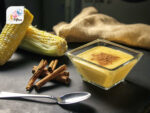
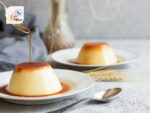

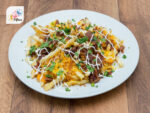
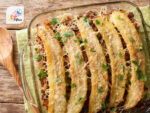
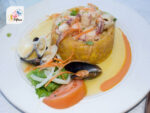
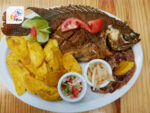
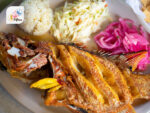
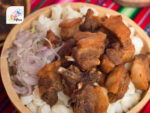
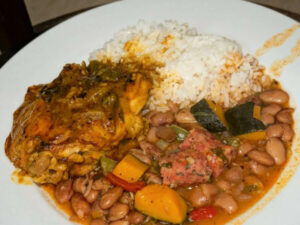
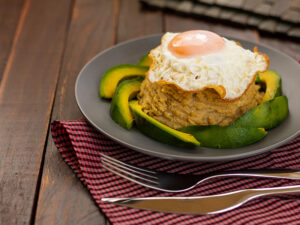
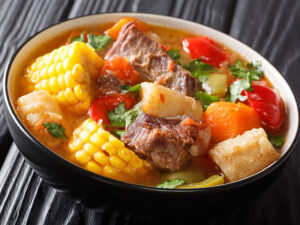
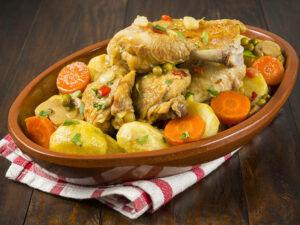
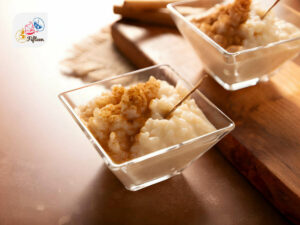
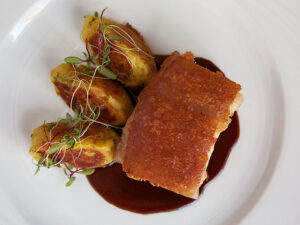
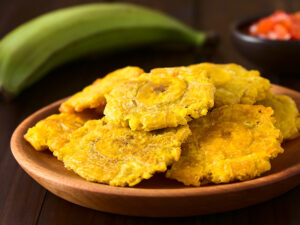
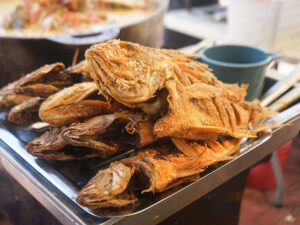
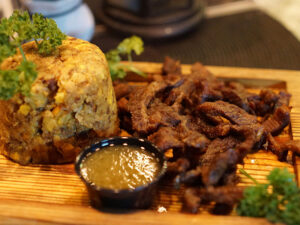
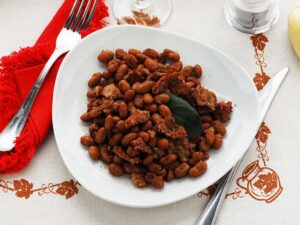
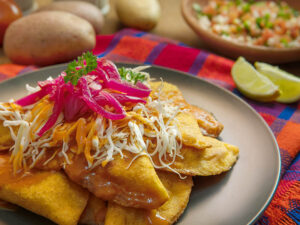
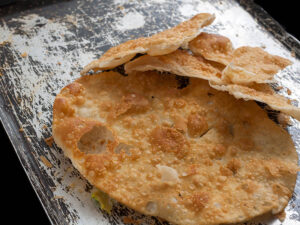
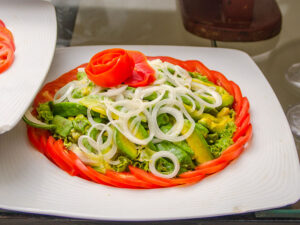
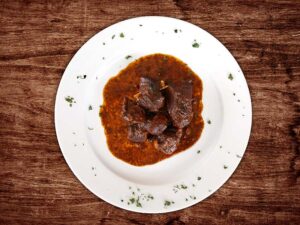
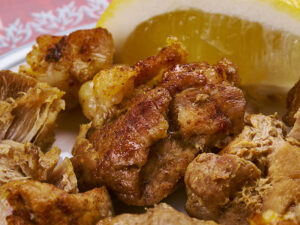
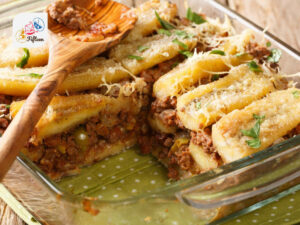
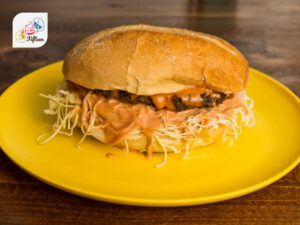

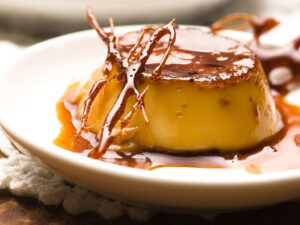
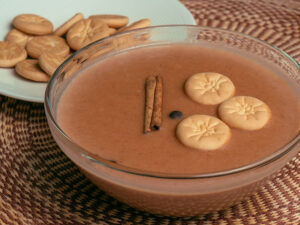
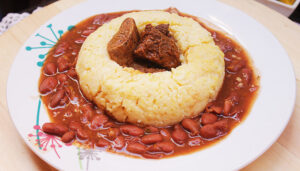
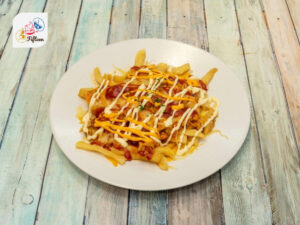
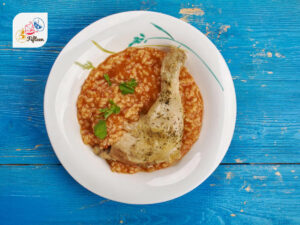
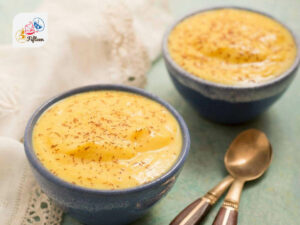
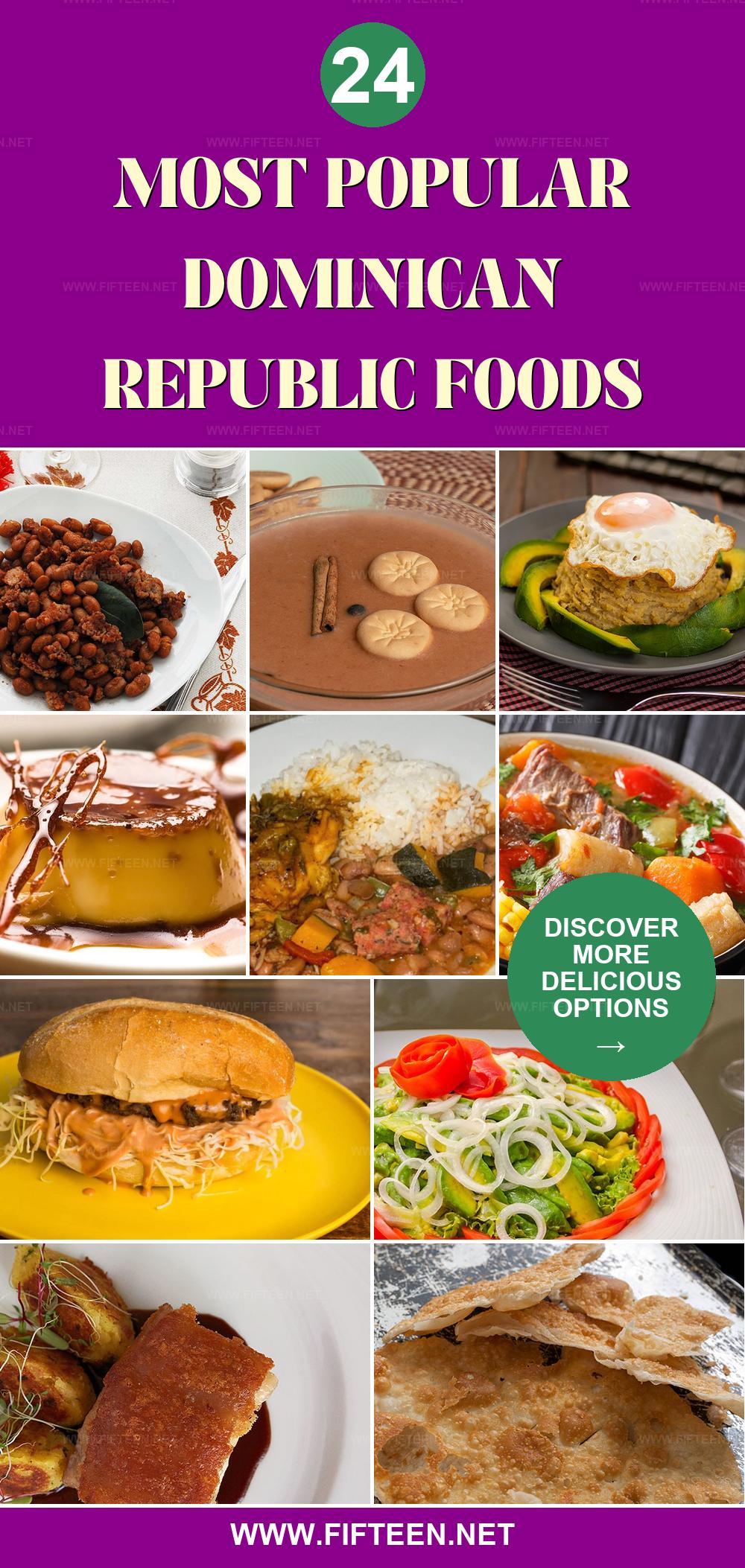
Jamie Scott
Editor in Chief, Senior Content Writer
Expertise
Home Cooking, Meal Planning, Recipe Development, Baking and Pastry, Food Editor, Cooking-video Maker, Western Food Evaluation Expert
Education
Le Cordon Bleu College of Culinary Arts
Local Community College, New York, NY
Jamie Scott is a skilled culinary expert and content creator specializing in Western cuisine. With over 15 years in the culinary field and formal training from Le Cordon Bleu, Paris, Jamie deeply understands how to blend nutrition with delicious flavors. His passion for cooking matches his commitment to making healthy eating accessible and enjoyable.
On Fifteen.net, Jamie brings a fresh perspective to classic dishes and beverages, offering readers insightful recipes, cooking tips, and a fresh view on meal planning that emphasizes taste, health, and simplicity.